|
|
| Разместил (Author): |
SergUA6  |
| Авторские права |
© http://www.radioscanner.ru |
|
|
Текст
|
SA update to version 6.1.0.0/1
In version 6.1.0.0/1 module analysis of OFDM signals is announced.
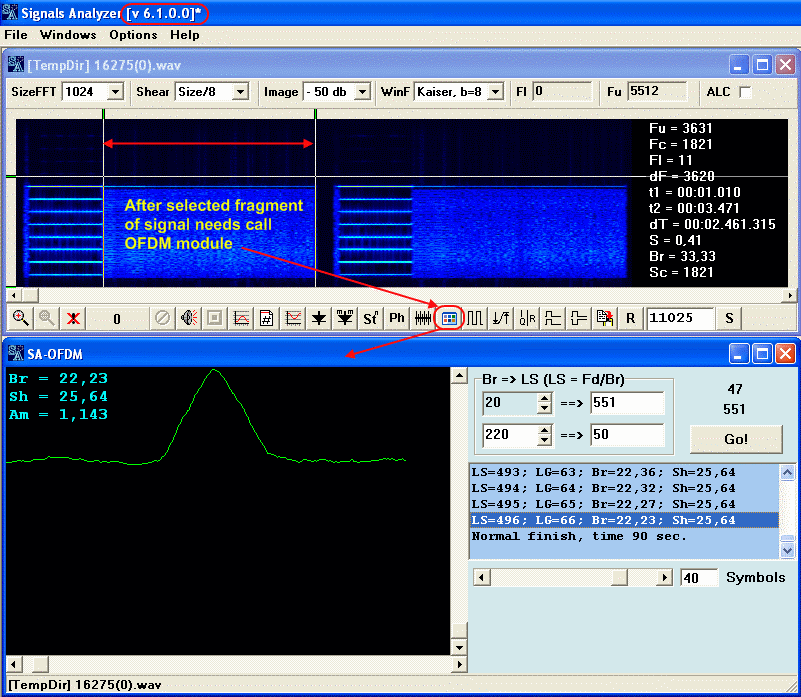
Before we will consider description of OFDM module and methods of operation with it, it is necessary to mention the bases of analysis OFDM. The matter is that if, for example, Phase plane module is not something strongly new, and for the majority of people PhasePlane module is clear enough by definition. In this or that sort PhasePlane module is present at many programs , and principles of work of PhasePlane module are well known in generall, while OFDM analysis is little-known enough area, and as far as we know, on the current moment, OFDM analysis tools are not represented(simply not exist) in other software analyzers.
Basic knowledge and knowledge of principles of OFDM analysis is necessary for effective work in OFDM module.
Let's consider, in general view, the order of OFDM symbols.
OFDM symbol - is the one clock of a signal or signal’s time segment, during which the phase and amplitude of sub-carriers/sub-channels is constant and do not change. (each channel has it's own specific phase and amplitude).
Change of the symbol is occurring with clock frequency of manipulation.
For different symbols, amplitudes and phases of sub-carries/sub-channels can vary (as rule they vary it depends of sub-carriers modulation sort), but within the symbol's limits they are constant. In OFDM symbol, so-called cyclic prefix (CP) is inserted: some part of the symbol is copying from the end in the beginning. It solves an array of problems with interference immunity. Schematically it looks approximately so:
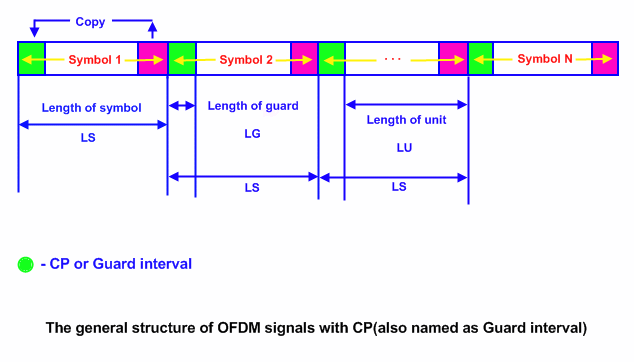
Initially, at the stage of creation, OFDM symbol consists only from LU, it is "pure" OFDM symbol, and there is the task to receive it(pure OFDM symbol) on the reception/receiving.
At insertion of CP the real OFDM symbol is obtained. The real OFDM symbol - is physically transferred. As it is easy to notice, the real symbol has duration LS = LU + LG, and this duration is more, then duration of the initial OFDM symbol: that in practice leads to lowering of actual transfer rate/speed OFDM from the transferring OFDM speed, which could be possibly accessible.
To receive demanded LU from LS is easy enough, in general case: it is necessary simply to throw out first countings, in LG number, from accepted series of countings of the signal, the rest of countings, in case of exact synchronization by the time, will contain only LU.
All it is good, when LS and LG are precisely known. At the analysis, there is a task of definition and finding LS and LG, it is very not simple and computationally the extremely capacious problem.
Let's consider, what mechanisms can be used for a finding and definition of LS and LG values, in the conditions of complete uncertainty (and vagueness). Such is indeed the case with OFDM analysis task.
Not a secret, and it is obvious that LG, in case of it’s length exact definition, duration and beginning of LS, will have unambiguous correlation with end LS, as LG is the copy of end LS.
Let's suppose that somehow LS and LG values are defined. How in this situation, to define exact position LS in the researched stream of countings? Very simple:
1) It is necessary to take sampling of countings with length=LS
2) and to calculate correlation of LG segment with the end of LS segment
3) after we need to shift sampling on one counting and again to calculate correlation,
4) we need to repeat this cycle LS quantity times.
As the result we will receive LS quantity of correlations, maximum from it - will be an exact position of beginning LS.
Actually it is standard enough task of calculation of correlation, but specificity of concrete conditions leads to interesting enough theoretical and practical results. In other words, we are searching for correlative function of two identical rectangles, and the result of this function is well-known - it is the triangle, which top is precisely shows the moment of coincidence of these rectangles. It looks approximately so.
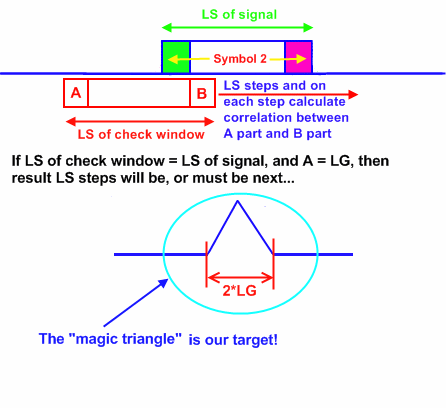
Basically, on searches of this "Magic Triangle" OFDM analysis is grounded/based. Certainly, if we are searching correlation within the limits of one symbol, then chances to detect it are not high. "Magic triangle", in this case, is expressed not so brightly as it would be desirable. However, in statistically large space, if to summarize correlation on several hundreds or at least tens symbols, then this triangle will be expressed brightly enough and expressively.
Thus, OFDM analysis algorithm, in the common form looks like this:
1)Large enough sampling of a signal is taken
2)this sampling should contain several hundreds or at least tens(in bad case) of expected maximum LS values
3)and further, starting from any minimal LS value, it is necessary consistently to calculate correlation for all LG of LS
4) the result is analyzed on the subject of the "magic triangle", or it is simply displayed after a preliminary rough estimation.
It is necessary to apply this algorithm for all LS values from minimal to maximal.
If the signal is really classical OFDM with CP, and both the minimum and maximum values of calculated LS are selected correctly, that is the signal's characteristics are getting in these boundaries, then the triangle will be detected. But there is the serious problem, when this triangle will be detected?
At all theoretical validity and correctness, this algorithm generally demands the grandiose calculations. Small enough maximum durations of LS, for example an order 300-400, demand 1 hour and more to realize this algorithm on such durations, by front solutions.
The situation is aggravated with the fact, that the dependence is very nonlinear, and if, for example,
maximum duration LS = 400, then it takes hour for the analysis, duration in 500-600 does already demand several hours, with further increasing of duration, time required for analysis is increasing almost to infinity. Thus, the task of "magic triangle" detection rests only in time. In OFDM analysis it is most time expensive and badly optimized computationally problem.
As soon as LG is found and LS is positioned, it is formally possible to consider that the task of analysis OFDM is done, because LU=LS - LG, and LU allows precisely demodulate the symbol by realizing FFT on it. Also LS unambiguously defines:
1) speed of manipulation as Fd (signal’s sampling rate/)/LS,
2) and LU as spacing between sub-carriers and sub-channels as Fd/LU
The quantity of channels is defined by results of FFT.
It is possible to consider the theoretical part of this SA update as complete, at least now you know basics and principles of OFDM analysis, and appearance of "magic triangle" should not cause questions.
We managed to increase speed of OFDM analysis more than in 30 times, and seems like there is still reserve.
Already now, on the real DRM signal the SA defines and finds the necessary parameters within 12 minutes at 40 symbols in the sum, and in time about 2 minutes at 10.
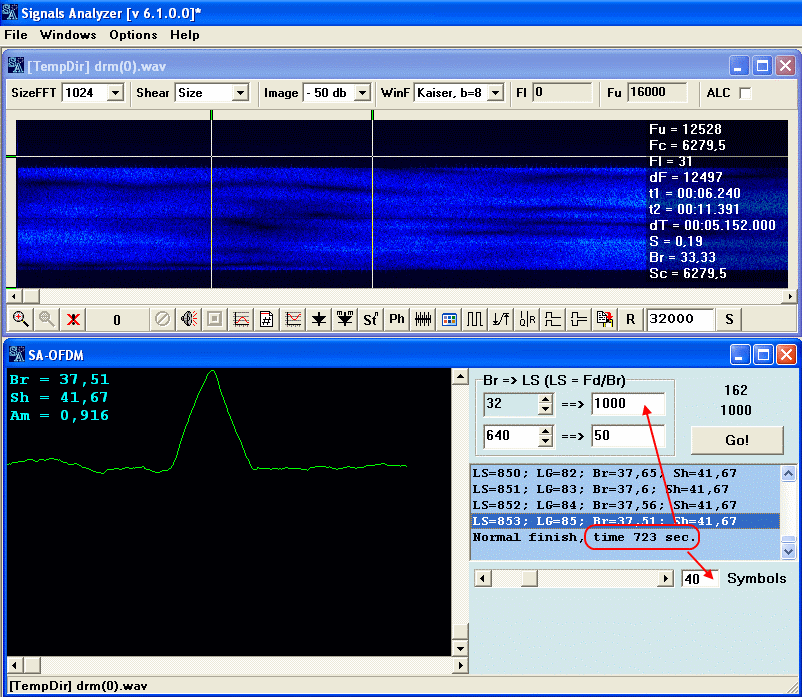
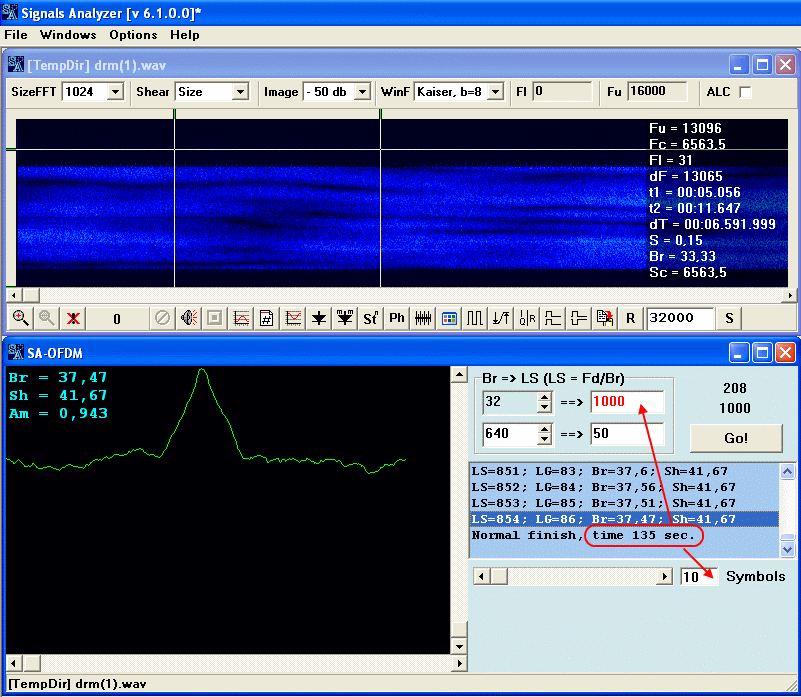
Current implementation of OFDM module in SA, solves only tasks of searching of LS and LG. The matter is that if we will lay out at once everything, there will be problems with understandending of principles of OFDM module work. Current OFDM module implementation - is simply the first step in analysis OFDM, which needs to be mastered well, because on this first step all further OFDM methods of OFDM module are based. Please be attentive and master this basic step, because we will not come back to it anymore . Even in such sort, current SA OFDM module is extremely powerful tool. We have spent months on it, and now with its help OFDM analysis becomes clear and can be applied in few minutes.
General view of OFDM module and it's description
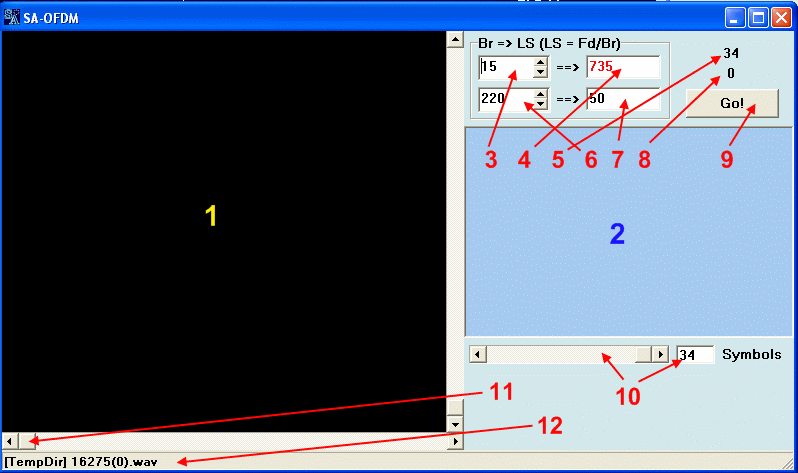
1) working window for graphics and other information outputting(displaying)
2) results of SA searching for suitable LS and LG values
3) minimal clock frequency, on which analysis is ended. Whole (integer) numbers only!
4) minimal clock frequency re-counted into countings. Just for information.
5) maximal number of OFDM symbols, which can be analyzed.
6) maximal clock frequency, from which the analysis is begin. Whole (integer) numbers only!
7) maximal clock frequency re-counted into countings. Just for information.
8) processing, where the length of currently analyzed LS is displayed
9) launch/stop of OFDM analysis process
10) quantity of OFDM symbols, on which correlation is counted. If it will be less then 40, then the window 4 becomes red, that speaks about low reliability of results.
11) navigation on the file's(which is loaded in OFDM module) fragment. Left layout is beginning, right layout - is end.
12) Name of the file, which fragment is loaded.
How does the operation with OFDM module look?
- Select the necessary fragment of OFDM signal on the spectrum, in the working window, launch/call OFDM module.
- Set low bound of expected frequency manipulation in the window 3. In case, if there are no any suppositions, I will tell that frequency of manipulation lower then 20 hertz is extremely seldom, but in general be you must oriented on the window 4. The quantity of countings above 1000 leads to very long time of calculations, and if this quantity is about 2000 or 3000 chances to wait endless are very high. The maximum quantity is 1200, and it should be applied only in cases, when it is strongly necessary.
- The clock rate high bound - is the window 6, it is poorly influences on the calculation time, the main thing is that it would not appear below then real, over wise the program simply will not find anything. I usually set it 300-400 hertz, but depends of the record of course.
- Set quantity of the symbols, which program will analyze at the same time. It is impossible to set quantity of the symbols less than 10. The maximum possible quantity is displayed in the window 5. The program inspects quantity of the symbols and if it is less than then 40, SA considers it as too small for the reliable statistics, thus the window 4 will be red. Although, to take quantity of the symbols far more then 40 is also bad, because time of calculations sharply increases, and in most cases, even 10 symbols give a good result, but if there is a possibility, it is better to take 40 symbols or about it. That’s All!
- Now Hit GO! And be ready to drink calmly nice cup of coffee or tea, in case, if you specified 1000 countings in LS and more then 40 symbols.
The process of OFDM analysis can be interrupt at any time, but you won't be able to change parameters in the window 3 after it. To change this parameter you need to discard/drop all results by double-mouse-click in the window 3.
What we get from the result of SA OFDM module work?
The program outputs the list of combinations LS and LG, which could be interesting in its opinion to an analyst. Criteria of selection are soft enough, because risk to skip really important moment is always exists.
Usually, in overwhelming majority of cases "the magic triangle" is easily recognized by it's appearance and amplitude - it's maximum. But sometimes, and of course you will meet such signals sooner or later, there are several magic triangles, and there will be the hard question: which one is the right one?
The choice of this or that position in the window 2, outputs the graphic in the window 1, with current for this position values of clock frequency, frequency spacing of the grid of channels and amplitude of peak. The graphic is standardized, and to define which one is bigger or lesser is not possible by appearance.
Moving on a file by slider, occurs in two modes:
1)on countings - if to press slider's pointers
2)and by symbols - if to press between the slider and pointer.
While moving slider, you move in random steps.
As I was already spoken, further we will expand and develop OFDM module to receiving of constellation of the separate channel, to compensation of inaccuracies of sampling rate and displacement by frequency, and if it ill be possible, to OFDM module full automation of putting to rights parameters of record.
We are also planning to write detailed article about work in SA OFDM Module, because possibilities of this module are great, and some part of very vexed questions(which are often discussed on forums), can be easily enough solved with SA OFDM module help.
Good luck.
|
|
|
|
Добавлять комментарии могут только зарегистрированные, активировавшие регистрацию и не ограниченные в доступе участники сайта!
|
| Файл создан: 18 Oct 2009 22:08, посл. исправление: 18 Oct 2009 22:16 |
|

